Donegal Mart has a good name for high-end weanlings and Friday’s sale had a few choice offerings.
The weanling always has a quiet start to the year, with small numbers moving out in January and February.
March sees the first of them come out for sale and it’s generally the best ones that are picked to go first.
A few exporters have kept the lighter weanling trade solid over the last few months and the return of a few heavy bull producers has also meant that the heavier weanling has improved in price accordingly.

This May 2020-born Charolais heifer weighed 474kg and sold for €1,420 (€2.99/kg).
In the 200kg to 300kg bull category, a number of grass buyers kept the trade alive.
These weanlings ranged in price from €2.60/kg to €3.05/kg, with a couple of high-end lots breaking the €3/kg barrier.
In the 300kg to 400kg category, prices ranged from €2.50/kg to €2.90/kg, with a top call of €1,080 for a 364kg Charolais bull.
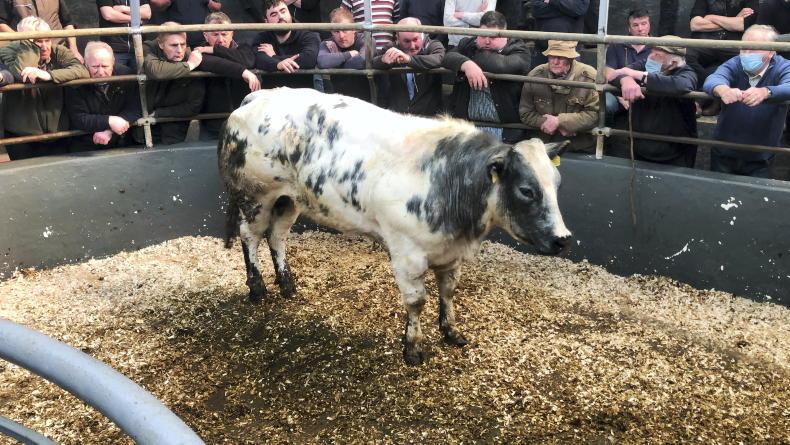
This February 2021-born Belgian Blue heifer weighed 558kg and sold for €1,900 (€3.40/kg).
Heavier weanlings over 400kg were being snapped up by a few big feeders and were generally trading around €2.60/kg to €2.70/kg, with a top call of €1,210 being paid for a 436kg Charolais bull.
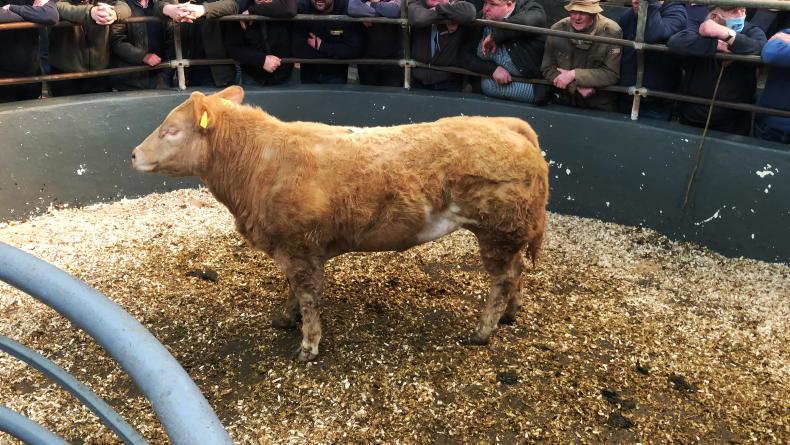
This March 2021-born Charolais heifer weighed 366kg and went home unsold at €1,850 (€5.05/kg).
In the heifer weanling section, there was a super trade for lighter weanlings, with up to €3.40/kg paid. The general run of 300kg to 400kg heifers were making from €2.60/kg to €2.90/kg, with the top call of €1,420 being paid for a 474kg Charolais heifer.
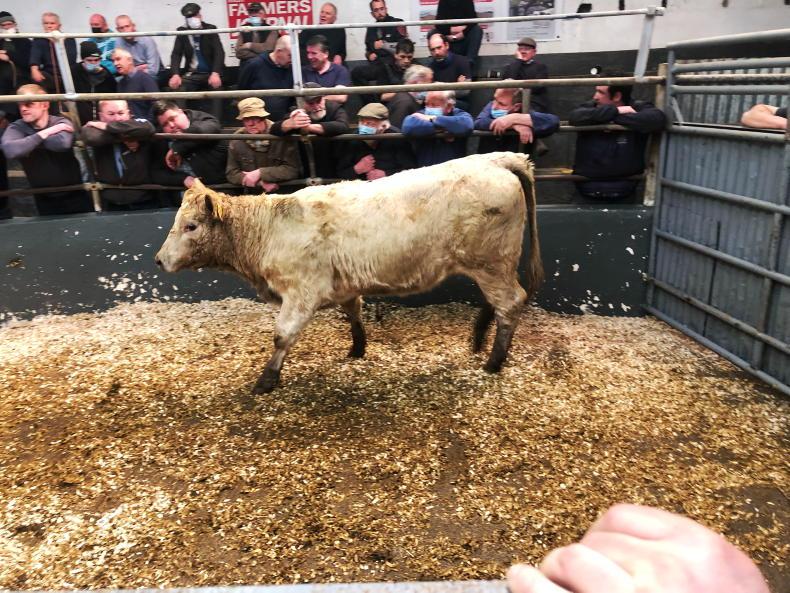
This March 2021-born Charolais heifer weighed 370kg and sold for €970 (€2.62/kg).
Heavier heifers were also a real solid trade, with €2,230 being paid for a 714kg Charolais heifer. A show-type Belgian Blue heifer weighing 558kg hit €1,900.
In the dry cow section, it was a similar story to previous weeks, with cows selling to €2.43/kg, with a top call of €1,280 being paid for a 895kg Limousin cow.

This June 2021-born Charolais heifer weighed 358kg and sold for €1,100 (€3.07/kg).
In the suckler ring, prices ranged from €1,200 to €2,250, with some of the best prices being paid for cows with calves at foot.
Speaking to the Irish Farmers Journal, Donegal Mart manager Eimear McGuiness said: “Donegal is normally later country for grass buyers, but the good weather has meant a few of the earlier buyers have moved out this week.
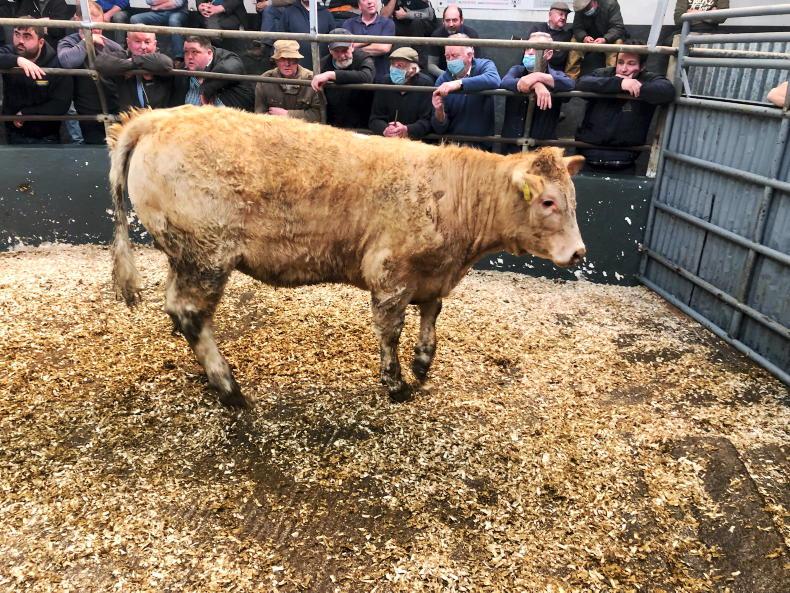
This March 2021-born Charolais heifer weighed 420kg and sold for €1,190 (€2.83/kg).
“Forward stores are an electric trade, with a few factories and wholesalers fighting it out for anything that is fit for slaughter or coming close to slaughter.
“With meal and fertiliser prices where they are, farmers need cattle prices to stay up there to cover costs this year.”
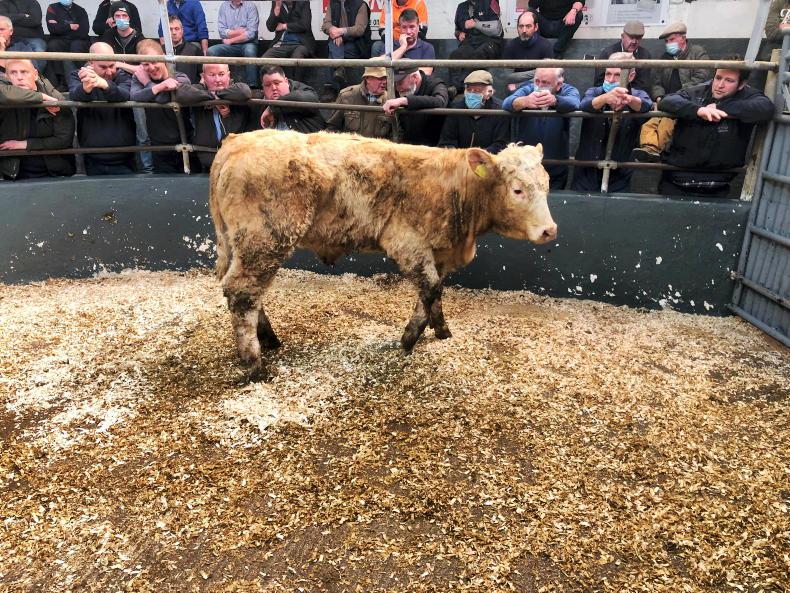
This April 2021-born Charolais heifer weighed 416kg and sold for €1,210 (€2.90/kg).

This April 2021-born Limousin heifer weighed 308kg and sold for €830 (€2.70/kg).
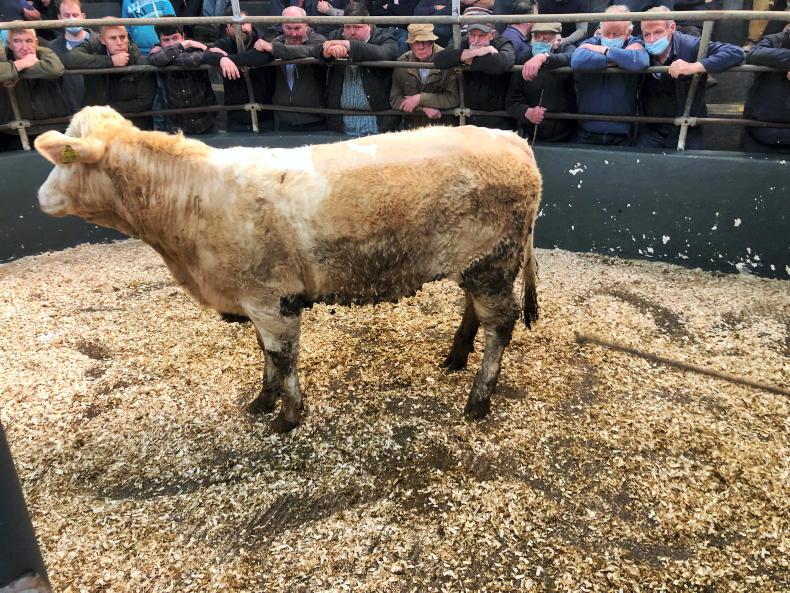
This March 2021-born Simmental heifer weighed 416kg and sold for €980 (€2.22/kg)

This April 2021-born Charolais heifer weighed 382kg and sold for €1,070 (€2.80/kg).

This August 2019-born Charolais heifer weighed 714kg and sold for €2,230 (€3.12/kg).
Donegal Mart has a good name for high-end weanlings and Friday’s sale had a few choice offerings.
The weanling always has a quiet start to the year, with small numbers moving out in January and February.
March sees the first of them come out for sale and it’s generally the best ones that are picked to go first.
A few exporters have kept the lighter weanling trade solid over the last few months and the return of a few heavy bull producers has also meant that the heavier weanling has improved in price accordingly.

This May 2020-born Charolais heifer weighed 474kg and sold for €1,420 (€2.99/kg).
In the 200kg to 300kg bull category, a number of grass buyers kept the trade alive.
These weanlings ranged in price from €2.60/kg to €3.05/kg, with a couple of high-end lots breaking the €3/kg barrier.
In the 300kg to 400kg category, prices ranged from €2.50/kg to €2.90/kg, with a top call of €1,080 for a 364kg Charolais bull.

This February 2021-born Belgian Blue heifer weighed 558kg and sold for €1,900 (€3.40/kg).
Heavier weanlings over 400kg were being snapped up by a few big feeders and were generally trading around €2.60/kg to €2.70/kg, with a top call of €1,210 being paid for a 436kg Charolais bull.

This March 2021-born Charolais heifer weighed 366kg and went home unsold at €1,850 (€5.05/kg).
In the heifer weanling section, there was a super trade for lighter weanlings, with up to €3.40/kg paid. The general run of 300kg to 400kg heifers were making from €2.60/kg to €2.90/kg, with the top call of €1,420 being paid for a 474kg Charolais heifer.

This March 2021-born Charolais heifer weighed 370kg and sold for €970 (€2.62/kg).
Heavier heifers were also a real solid trade, with €2,230 being paid for a 714kg Charolais heifer. A show-type Belgian Blue heifer weighing 558kg hit €1,900.
In the dry cow section, it was a similar story to previous weeks, with cows selling to €2.43/kg, with a top call of €1,280 being paid for a 895kg Limousin cow.

This June 2021-born Charolais heifer weighed 358kg and sold for €1,100 (€3.07/kg).
In the suckler ring, prices ranged from €1,200 to €2,250, with some of the best prices being paid for cows with calves at foot.
Speaking to the Irish Farmers Journal, Donegal Mart manager Eimear McGuiness said: “Donegal is normally later country for grass buyers, but the good weather has meant a few of the earlier buyers have moved out this week.

This March 2021-born Charolais heifer weighed 420kg and sold for €1,190 (€2.83/kg).
“Forward stores are an electric trade, with a few factories and wholesalers fighting it out for anything that is fit for slaughter or coming close to slaughter.
“With meal and fertiliser prices where they are, farmers need cattle prices to stay up there to cover costs this year.”

This April 2021-born Charolais heifer weighed 416kg and sold for €1,210 (€2.90/kg).

This April 2021-born Limousin heifer weighed 308kg and sold for €830 (€2.70/kg).

This March 2021-born Simmental heifer weighed 416kg and sold for €980 (€2.22/kg)

This April 2021-born Charolais heifer weighed 382kg and sold for €1,070 (€2.80/kg).

This August 2019-born Charolais heifer weighed 714kg and sold for €2,230 (€3.12/kg).

















 This is a subscriber-only article
This is a subscriber-only article







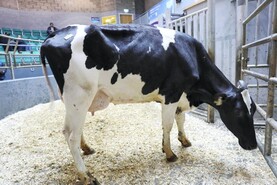



SHARING OPTIONS: